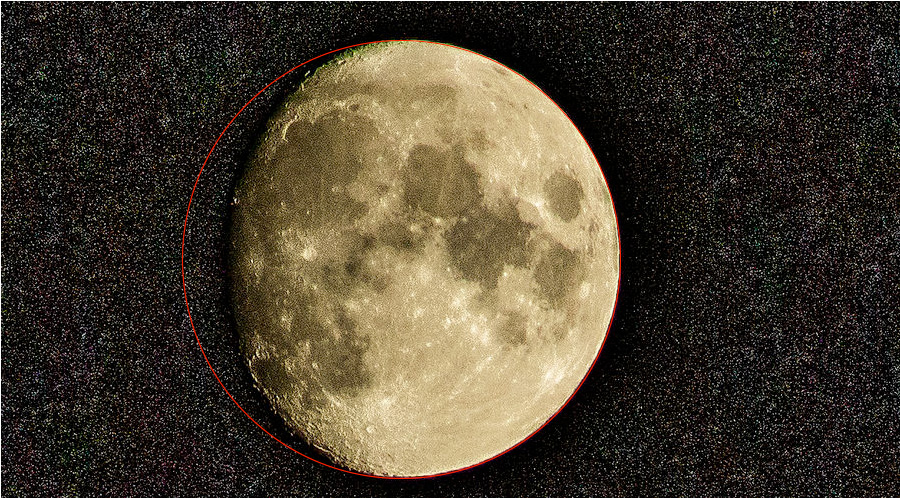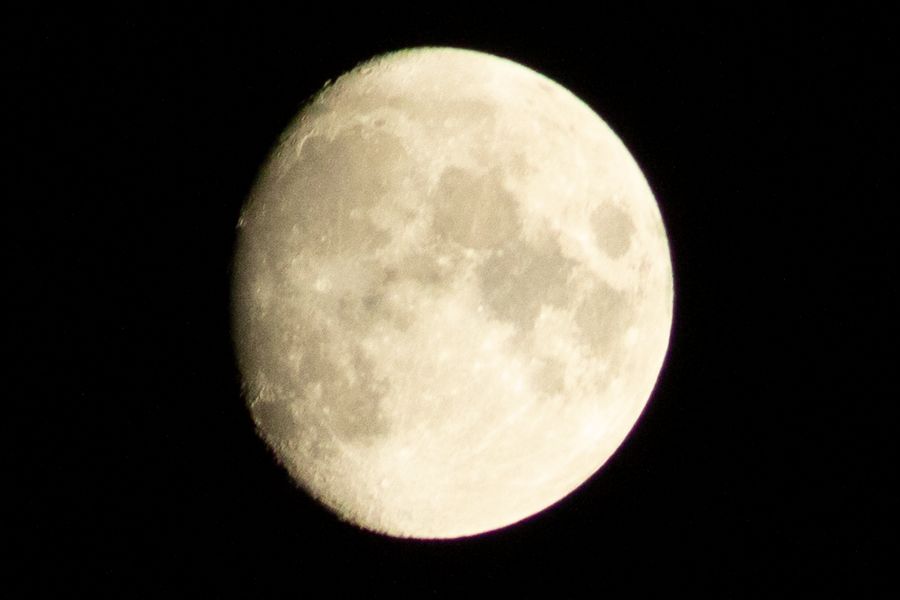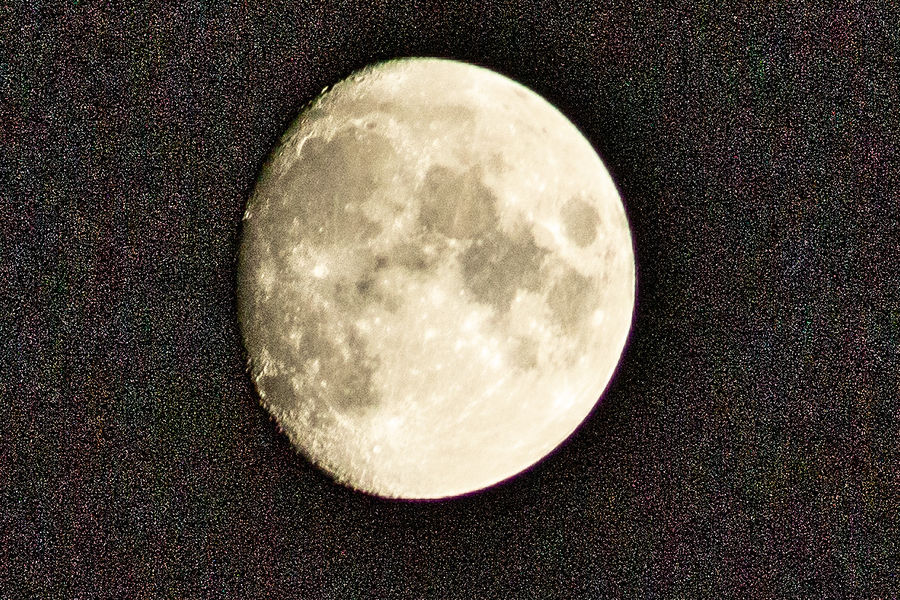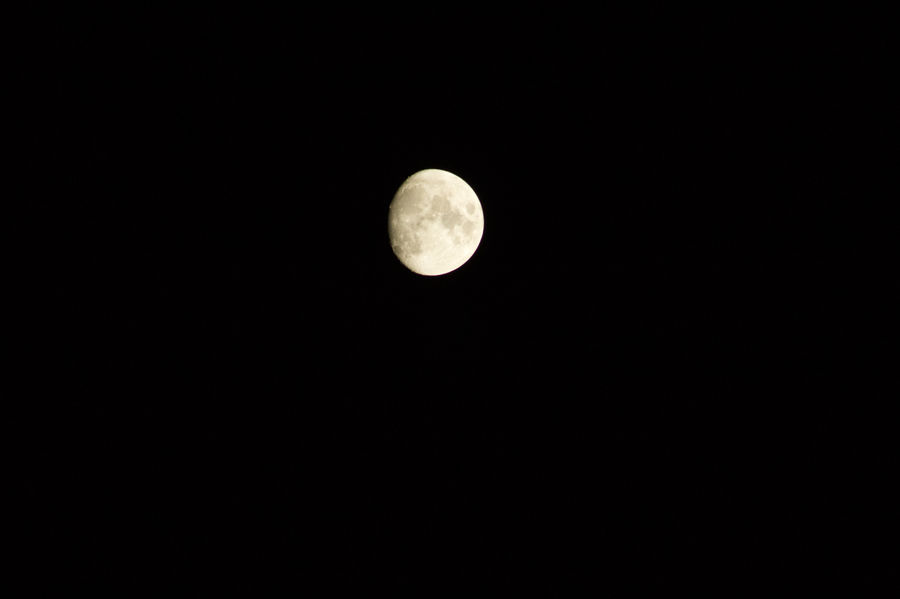Check out Panorama section of our forum.
What am I seeing?
Sep 25, 2021 09:29:10 #
So - attached is the original photo. I was mistaken with my ISO - I used 1600 rather than 1300. The reason for that was to see if I could get some stars as well as using a higher shutter speed. This was my first try at taking moon shots with this camera.
In processing I used Photoshop Elements 2020.
Zoom to 100%
Exposure t0 -2.15
Contrast to +88
Clarity - begin to see "stars" at +34 kept moving up to the end for the final result.
I am going to do an experiment tonight in my cellar - no lights - same settings - and see if I get "stars".
I will let you know what happens.
I am very interested in hearing what you do - and the results of my original. Hope I am attaching it correctly.
Frav
In processing I used Photoshop Elements 2020.
Zoom to 100%
Exposure t0 -2.15
Contrast to +88
Clarity - begin to see "stars" at +34 kept moving up to the end for the final result.
I am going to do an experiment tonight in my cellar - no lights - same settings - and see if I get "stars".
I will let you know what happens.
I am very interested in hearing what you do - and the results of my original. Hope I am attaching it correctly.
Frav
Sep 25, 2021 11:57:43 #
FRAV wrote:
So - attached is the original photo. I was mistak... (show quote)
I believe the Clarity function is your problem.
What Exactly Is Clarity?
What is clarity? Clarity is a local contrast increase that focuses on the mi-tones of the image. If differs from sharpness, because whereas increasing sharpness increases the contrast between dark and light tones, clarity increases the contrast within the middle tones of the image. The effect is similar to sharpening, but it brings out textures a bit more. In addition, digital noise isn’t as much of a problem as it is with sharpening increases.
Sep 25, 2021 12:29:11 #
So you believe the "stars" are an anomaly brought about by the clarity function?
Hopefully my experiment tonight will answer this.
Thanks
Hopefully my experiment tonight will answer this.
Thanks
Check out AI Artistry and Creation section of our forum.
Sep 25, 2021 15:55:32 #
FRAV wrote:
So - attached is the original photo. I was mistak... (show quote)
That is the correct look. The moon is in direct sun light and the exposure is just about right for it. That means that unless one of the very bright stars or planets is in the frame the sky should be black.
The softness on the focus of the moon is probably atmospheric distortion, haze etc.
A few days ago during one of my meanderings from interesting site to interesting site on line (I don't even remember where it was.) I found an article on how the observatories get those really sharp shots of the moon and planets. Besides the fact they are almost all at high altitude in areas where the atmosphere is noted for clarity they use very high speed bursts. They then go through them and delete the worst ones and use focus stacking with the rest to produce those ultra sharp shots of the moon or planets. In film days they just took lots of shots and dumped the ones that were not sharp and picking the best one to publish. The huge amounts of film used added up to a lot of money. Digital not only is cheaper but easier to do according to the short article.
So if I get any fairly clear nights with a moon I have to try that. Since I use dslr's it will be setup on my heaviest tripod, clamp everything down solid; set my exposure; focus; have the mirror lock up with a short delay before the shutter goes into the highest speed burst the camera will do until the buffer is full. Then try their sort and delete + focus stack and see how I do. My old buddy Murphy says that if I do that I will have one frame where the whole moon is in focus and will have wasted my time & efforts on all the others. Oh well, that works also.
One additional hint. The moon is moving across the sky, the movement shows more the longer the lens used. A few years ago when I went through a "Moon" phase in my photography and with a 600+1.4x I could actually see it move from one side of the frame to the other while I was setting everything. So I would set up with the leading edge of the moon just coming in frame focus etc. then go to the back view finder and hold the remote as the moon moved into the frame and setting off the shutter when it hit center or the position I wanted with trees house etc. in the foreground. Then without moving a thing I would change the exposure settings and refocus to get the trees, houses, horizon etc. and just wait for the moon to move out of the frame far enough to cut down on the light pollution from the bright moon. Then stack those two frames for an image.
Sep 25, 2021 16:23:23 #
Sep 25, 2021 17:19:19 #
I can see similar noise in the dark craters. Try taking a shot of a perfectly black surface, black paper or black foam board if you have some. Same settings and processing. Maybe you have too much contrast and/or sharpening in the processing and are magnifying sensor noise. Not stars IMO.
Sep 25, 2021 17:29:36 #
It is noise not stars. It is too dense especially with your optics. You couldn’t do that with Hubble.
Check out Printers and Color Printing Forum section of our forum.
Sep 25, 2021 17:29:49 #
It is noise not stars. It is too dense especially with your optics. You couldn’t do that with Hubble.
Sep 25, 2021 17:57:37 #
I agree with the above comments on this post, but what you generally see as "stars" are actually primarily galaxies.
Sep 25, 2021 18:42:50 #
FRAV wrote:
Thanks much! Hopefully, a few other folks will see that you posted the raw.So - attached is the original photo. I am very interested in hearing what you do - and the results of my original. Hope I am attaching it correctly.
I can't tell! It does seem like there are stars, but they are faint. This is a bit of clarity (obviously not enough, lol) in Affinity Develop module, then some futzing around in Studio 2. As suspected, a heavy hand does bring out a lot of artifacts.
Sep 25, 2021 19:44:19 #
mundy-F2
Loc: Chicago suburban area
FRAV wrote:
With a few clear nights available and an almost fu... (show quote)
Wow, beautiful picture.
Mundy
Check out Advice from the Pros section of our forum.
Sep 25, 2021 21:55:38 #
I don't think this is right. The moon is in a gibbous phase, with the left side in shadow. But the "stars" encroach into where the dark side of the moon should be. Meanwhile there is a gap of black between the sunlit side of the moon on the right and the stars.
Zooming in, it looks more like a picture of the moon, cut out, and laid onto a black textured surface and photographed.
Zooming in, it looks more like a picture of the moon, cut out, and laid onto a black textured surface and photographed.
Sep 26, 2021 00:08:59 #
FRAV wrote:
With a few clear nights available and an almost fu... (show quote)
Frav, it appears that you're seeing an effect of post-processing. I've attached your image (Fig 1) overlayed with a circle, since the moon is almost a perfect sphere. There should be no star images visible inside the circle since the moon, both the light area and the shadow portion (on the left) would block the light.
I downloaded your raw file (Fig 2) and using photoshop, exported the SOOC image (ie. no post-processing other than cropping similar to you posted image) as a png file. There are no stars seen in the raw file.
In Fig 3, I only made one post-processing change, increasing clarity. The noise started showing at clarity of +20 and got increasingly worse until the noise was very prominent, duplicating your image. This also created noise in the shadow area of the moon, since this was as dark as the background sky.
As others stated, correctly exposing for the moon, would significantly underexpose for the stars since their luminosity is so much lower.
Hope this helps explain your results.
Mike
Fig 1

Fig 2 - unprocessed raw file

(Download)
Fig 3 - processed raw file applying only clarity, +100

(Download)
Sep 26, 2021 23:18:23 #
Sep 26, 2021 23:32:02 #
Stars can be had on a full moon … but it ain’t easy ..excuse the terrible looking moon ..
If you want to reply, then register here. Registration is free and your account is created instantly, so you can post right away.









